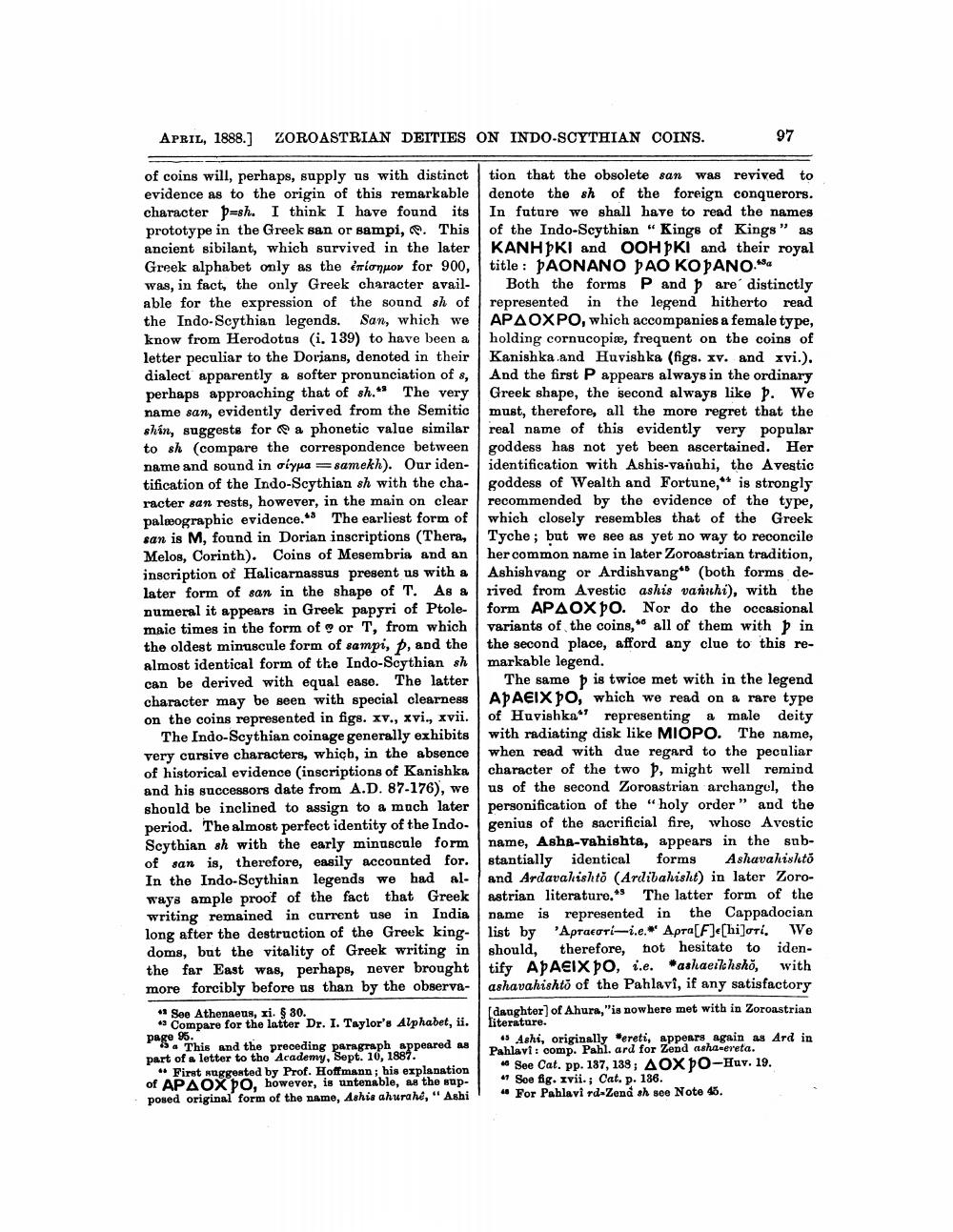________________
APRIL, 1888.]
ZOROASTRIAN DEITIES ON INDO-SCYTHIAN COINS.
97
of coins will, perhaps, supply us with distinct tion that the obsolete san was revived to evidence as to the origin of this remarkable denote the sh of the foreign conquerors. character p=sh. I think I have found its In future we shall have to read the names prototype in the Greek san or sampi, . This of the Indo-Scythian "Kings of Kings" as ancient sibilant, which survived in the later KANHPKI and OOH PKI and their royal Greek alphabet only as the emionov for 900, title: PAONANO PAO KOPANO.184 was, in fact, the only Greek character avail- | Both the forms P and pare distinctly able for the expression of the sound sh of represented in the legend hitherto read the Indo-Scythian legends. San, which we APAOXPO, which accompanies a female type, know from Herodotas (i. 139) to have been a holding cornucopiae, frequent on the coins of letter peculiar to the Dorians, denoted in their Kanishka and Huvishka (figs. xv. and xvi.). dialect apparently a softer pronunciation of s, And the first P appears always in the ordinary perhaps approaching that of sh." The very | Greek shape, the second always like p. We name san, evidently derived from the Semitic must, therefore, all the more regret that the shin, suggests for a phonetic value similar real name of this evidently very popular to sh (compare the correspondence between goddess has not yet been ascertained. Her name and sound in oiyua =samekh). Our iden- identification with Ashis-vandhi, the Avestic tification of the Indo-Scythian sh with the cha- | goddess of Wealth and Fortune," is strongly racter san rests, however, in the main on clear recommended by the evidence of the type, palmographic evidence. The earliest form of which closely resembles that of the Greek san is M, found in Dorian inscriptions (Thera, Tyche; but we see as yet no way to reconcile Melos, Corinth). Coins of Mesembria and an her common name in later Zoroastrian tradition, inscription of Halicarnassus present us with a Ashish vang or Ardishvang (both forms delater form of san in the shape of T. As a rived from Avestic ashis varuhi), with the numeral it appears in Greek papyri of Ptole- form APAOX PO. Nor do the occasional maic times in the form of or T, from which variants of the coins, all of them with in the oldest minuscule form of sampi, p, and the the second place, afford any clue to this reAlmost identical form of the Indo-Scythian sh markable legend. can be derived with equal ease. The latter The same p is twice met with in the legend character may be seen with special clearness APAEIX PO, which we read on a rare type on the coins represented in figs. xv., xvi., xvii. of Huvishka" representing a male deity
The Indo-Scythian coinage generally exhibits with radiating disk like MIOPO. The name, very cursive characters, which, in the absence when read with due regard to the peculiar of historical evidence (inscriptions of Kanishka character of the two Þ, might well remind and his successors date from A.D. 87-176), we us of the second Zoroastrian archangel, the should be inclined to assign to a much later personification of the "holy order” and the period. The almost perfect identity of the Indo- genius of the sacrificial fire, whose Avestic Scythian sh with the early minuscule form name, Asha-vahishta, appears in the subof san is, therefore, easily accounted for. stantially identical forms Ashavahishto In the Indo-Soythian legends we had al- and Ardavakishto (Ardibalisht) in later Zoroways ample proof of the fact that Greek astrian literature. The latter form of the writing remained in current use in Indianame is represented in the Cappadocian long after the destruction of the Greek king- list by 'Apraeori-i.. Apra[F]e[hi]oti. We doms, but the vitality of Greek writing in should, therefore, not hesitate to identhe far East was, perhaps, never brought tify APAEIX PO, i.e. *ashaeilchsho, with more forcibly before us than by the observa- ashavahishto of the Pahlavi, if any satisfactory * See Athenaeus, xi. $ 80.
[daughter of Ahura, "is nowhere met with in Zoroastrian * Compare for the latter Dr. I. Taylor's Alphabet, ii. literature. page 95. 15. This and the preceding paragraph appeared as
Ashi, originally *ereti, appears again as Ard in part of a letter to the Academy, Sept. 10, 1887.
Pahlavi : comp. Pahl. ard for Zend asha-ereta. . First suggested by Prof. Hoffmann; his explanation
See Cat. pp. 187, 138; AOX PO-Huv. 19. of APAOX PO, however, is untenable, as the sup- * Soe fig. xvii.; Cat. p. 136. posed original form of the name, Ashis ahurahe, "Ashi! "For Pahlavi rd-Zená sh see Note 45.




